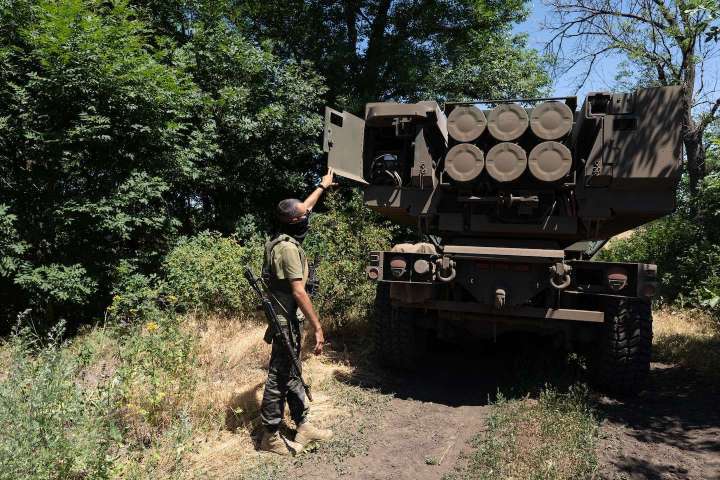As the Ukraine war grinds toward its sixth month, many analysts forecast a continuing bloody stalemate into winter. But several unpredictable military, political and diplomatic factors have emerged in this brutal war of attrition.
There are too many wild cards to forecast the Ukraine war

One new factor is the battlefield success of the U.S. rocket system known as HIMARS, which over the past several weeks has targeted Russian staging areas and command posts just inside Ukraine. After weeks of retreat in Donbas, Ukrainian forces are newly emboldened. Ukrainian generals complain that HIMARS are so effective they should have been delivered months ago, according to one European official.
Gen. Valerii Zaluzhnyi, the commander of Ukraine’s military, claimed in an internet post that “we have succeeded in stabilizing the situation,” thanks partly to the HIMARS. He said the U.S. missiles “have been used for targeted strikes on enemy control points and ammunition and fuel depots.”
Follow David Ignatius‘s opinions
FollowThe Pentagon, which was wary of delivering the HIMARS until it had “proof of concept” the Ukrainians could use them effectively, now seems convinced. “I think there has been significant impact on what’s going on, on the front lines,” a Pentagon official said last week.
Through this summer and fall, NATO’s priority will be delivering more of these missiles to Ukraine to reinforce the recent success. U.S. and European officials are mobilizing defense companies to speed weapons production, the European official said. And there’s a race to expand training of Ukrainian forces. Britain plans to train 10,000 soldiers every 120 days — a number that will be multiplied by other countries.
Ukrainian forces might feel confident enough to expand attacks this summer in the south, near Kherson, officials say. But the real impact of the new weapons and training could come next spring, after an expected winter lull in fighting. Ukraine will be better positioned to repel new Russian attacks and perhaps retake some territory, the European officials said.
Human leadership is the X-factor in any conflict. In this one, both Ukraine and Russia are benefiting from strong, unifying leadership from their presidents, Volodymyr Zelensky and Vladimir Putin. Predictions that these leaders would buckle under internal dissent have proved wrong.
Both presidents are polling well above where they stood before the war. In Ukraine, a poll released in May by the International Republican Institute registered 94 percent support for Zelensky. Domestic polls by Ratings Sociological Group show that support for Zelensky nearly tripled from December to February, from 31 percent to 91 percent. In Russia, a June poll by the Levada Center — whose numbers are viewed as broadly accurate — showed 83 percent approval of Putin, up 14 points from January, before the Russian invasion.
Zelensky governs what remains a fragmented country where corrupt oligarchs hold considerable power. He resisted prewar American urging to form a unity government, but until now, he has avoided any major internal blowups or witch-hunts.
Then came Sunday’s abrupt removal of Iryna Venediktova and Ivan Bakanov, the country’s prosecutor general and leader of its internal security service, respectively. Zelensky said they hadn’t been aggressive enough in pursuing pro-Russia sympathizers and suggested there were many more Ukrainians who were also disloyal. These moves were a jarring reminder of underlying tensions. But sources close to Ukrainian politicians say that, so far, Zelensky has managed to keep the broad mass of the country with him — and thereby tame the oligarchs.
If Zelensky makes more impulsive changes in his administration, he could jeopardize the unity that is his most precious asset. Rick Atkinson, author of a celebrated trilogy about World War II in Europe, offers a caution for any wartime leader: “Turnover in senior national leadership positions during wartime typically suggests stress fractures at the top, perhaps from colliding egos or the need for scapegoats when things are going badly.” That warning applies equally to Putin.
On the matter of alliances, Putin’s dreams of remaking the global order seemed to crumble after his plan for a quick decapitation of Zelensky’s regime failed. Rather than shattering NATO, Putin has galvanized it, drawing Sweden and Finland into the pact and putting new pressure on Russia’s northern flank. But the ever-wily Putin this week tried to reinforce his diplomatic position along the southern tier, traveling to Iran to meet with Ayatollah Ali Khamenei and Turkish President Recep Tayyip Erdogan.
Putin’s trip to Tehran is a creative attempt to gain political leverage by a leader who knows that brute Russian force of arms, alone, could dig Russia into a conflict from which it might not escape for decades. It’s also a reminder of the diplomatic and military wild cards that might alter the current gloomy forecast that both sides will slaughter their way to a deadlock — and that the ultimate outcome of this terrible war remains uncertain.






